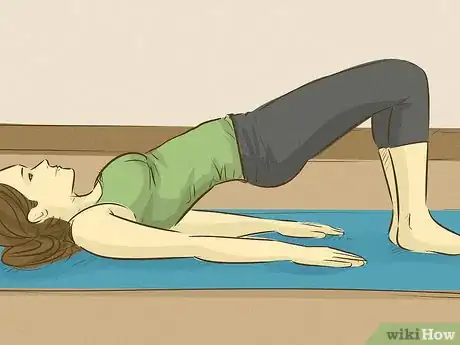This article was co-authored by Allison Romero, PT, DPT and by wikiHow staff writer, Danielle Blinka, MA, MPA. Dr. Allison Romero is a Pelvic Health Specialist, Physical Therapist, and the Owner of Reclaim Pelvic Therapy in the San Francisco Bay Area. With over a decade of experience, Allison specializes in comprehensive pelvic physical therapy treatments for pelvic floor dysfunction. She holds a Bachelor of Science in Kinesiology and Exercise Science from Sonoma State University and a Doctor of Physical Therapy from the University of Southern California. Allison is a board certified Physical Therapist in California and is a member of the American Physical Therapy Association-Section on Women’s Health and the International Pelvic Pain Society.
There are 13 references cited in this article, which can be found at the bottom of the page.
This article has been viewed 11,849 times.
Uterine prolapse is a common worry among women. Although uterine prolapse has many causes, it may be possible to prevent it in many cases. One of the best ways to possibly prevent uterine prolapse is performing kegel exercises, especially after giving birth. It’s also important to treat and prevent constipation, as it can cause uterine prolapse. Finally, you should avoid stressing your pelvic floor with a few lifestyle changes.[1]
Steps
Performing Kegel Exercises
-
1Squeeze your pelvic muscles for 3 seconds, then relax for 3 seconds. Focus your attention on engaging your muscles as you squeeze. During your rest break, focus on your breath. This is 1 rep. Do 3 sets of 10 squeezes.[2]
- You can do the exercises sitting, standing, or lying down. It’s best to do them while lying down when you first get started.
- Do your exercises daily.[3] You can spread them throughout the day or do them all at once. It’s a good idea to get in the habit of doing them at the same time each day.
-
2Increase your Kegel squeezes by 1 sec until you are holding for 10 secs. Add 1 second to your squeezes each week until you reach a maximum of 10 seconds. This slowly gets your muscles used to the strengthening exercise, while also challenging them.[4]
- Don’t push yourself to increase your hold times too quickly. Give your muscles the time they need to gain strength.
Advertisement -
3See an experienced personal trainer or physical therapist.[5] Choose a provider that has experience in helping women strengthen their pelvic floor. These individuals will be able to evaluate your muscle health and strength. They’ll also be able to show you how to correctly do the exercises.[6]
- Start by asking your doctor for a referral, as they are your best resource. If they cannot help you find a good trainer or physical therapist, check with local gyms.
Relieving Constipation
-
1Stay hydrated. Staying hydrated helps avoid constipation because it helps keep your system moving.[7] Drink at least 8 servings of 8 fluid ounces (240 mL) of fluids each day. Although it’s best to focus on water, remember that other fluids also help keep you hydrated, including items like soups and tea.[8]
- If you are very active to the point of sweating, you should drink more fluids to keep yourself hydrated. Additional fluids, such as water or sports drinks, will replenish the fluids you lost while sweating.
- Keep in mind that caffeine and alcohol can dehydrate you.[9]
-
2Eat high fiber foods. A high fiber diet can help you avoid constipation because it keeps your digestive system moving.[10] Women should eat 25 grams (0.88 oz) of fiber per day.[11]
- Excellent sources of fiber include vegetables and fruits, especially greens and produce with the skin on. Whole grains and legumes, such as beans, lentils, peas, and chickpeas, are also high in fiber.
- Fiber also helps you feel fuller longer, which can help you maintain a healthy weight.[12]
-
3Exercise for 30 minutes each day. Even light exercise provides benefits for your body. Staying active helps keep your stool moving through your body, which prevents constipation. Choose cardio exercise that matches your current fitness level. If you're starting a new exercise program, talk to your doctor, first. Here are a few great options:[13]
- Walking
- Dancing
- Aerobics
- Swimming
- Jogging
-
4Take bowel movements as soon as you feel the urge to go. When you feel the urge to go, it’s important that you use the restroom immediately. Holding your bowel movements can lead to constipation. At times, it may be inconvenient to go, but your health is what’s important.[14]
- However, it’s important not to strain while trying to go. If your body isn’t ready for a bowel movement, don’t try to force one.[15]
-
5See your doctor if you still experience constipation. Sometimes constipation can be caused by nerve issues, pelvic floor dysfunction, and certain medications. When this is the case, your doctor can help you identify ways to relieve your constipation, such as taking laxatives or doing your Kegel exercises.[16]
- Don’t attempt to relieve your constipation using laxatives or other treatments until you’ve gotten approval from your doctor. Since it's difficult to know the cause of your symptoms, taking unapproved medication can make your condition worsen.
Avoiding Stress on Your Pelvic Floor
-
1Maintain a healthy weight. Carrying extra weight puts extra pressure on your pelvic floor, increasing your risk of uterine prolapse. Eat a healthy, balanced diet and exercise for at least 30 minutes each day.[17]
- If you’re overweight, take steps to lose weight. Talk to your healthcare provider or a dietitian to identify the best diet and exercise program for your needs.
-
2Lift items safely. It’s important to lift with your legs, not your back. This protects not only your back muscles, but your pelvic floor as well. You should also hold items close to your body as you lift, not out in front of you. Avoid lifting heavy items, which can put too much stress on your body, including your pelvic floor.[18]
- If an item may be too heavy for you, ask for help with lifting it.
-
3Treat heavy coughing. Heavy, persistent coughing is another common stressor that can trigger uterine prolapse. This is most common with conditions like bronchitis, pneumonia, COPD, or chronic lung issues. Your doctor can treat your cough to minimize its effects.[19]
-
4Stop smoking. Smoking increases your risk of conditions that cause coughing, which also increases your risk of uterine prolapse. Quitting is hard, so talk to your doctor for recommendations to help you quit. You may be able to use a prescription medication, gum, or patches to help you quit.[20]
Expert Q&A
-
QuestionHow do you find your pelvic muscles?
 Allison Romero, PT, DPTDr. Allison Romero is a Pelvic Health Specialist, Physical Therapist, and the Owner of Reclaim Pelvic Therapy in the San Francisco Bay Area. With over a decade of experience, Allison specializes in comprehensive pelvic physical therapy treatments for pelvic floor dysfunction. She holds a Bachelor of Science in Kinesiology and Exercise Science from Sonoma State University and a Doctor of Physical Therapy from the University of Southern California. Allison is a board certified Physical Therapist in California and is a member of the American Physical Therapy Association-Section on Women’s Health and the International Pelvic Pain Society.
Allison Romero, PT, DPTDr. Allison Romero is a Pelvic Health Specialist, Physical Therapist, and the Owner of Reclaim Pelvic Therapy in the San Francisco Bay Area. With over a decade of experience, Allison specializes in comprehensive pelvic physical therapy treatments for pelvic floor dysfunction. She holds a Bachelor of Science in Kinesiology and Exercise Science from Sonoma State University and a Doctor of Physical Therapy from the University of Southern California. Allison is a board certified Physical Therapist in California and is a member of the American Physical Therapy Association-Section on Women’s Health and the International Pelvic Pain Society.
Pelvic Health Specialist If you’re having trouble identifying your pelvic muscles, focus on pulling up and squeezing in. You can also imagine sucking up a smoothie through a straw. For females this would be vaginally, and for males this could be through the penis or rectum.
If you’re having trouble identifying your pelvic muscles, focus on pulling up and squeezing in. You can also imagine sucking up a smoothie through a straw. For females this would be vaginally, and for males this could be through the penis or rectum.
References
- ↑ https://my.clevelandclinic.org/health/diseases/16030-uterine-prolapse
- ↑ Allison Romero, PT, DPT. Pelvic Health Specialist. Expert Interview. 2 December 2020.
- ↑ Allison Romero, PT, DPT. Pelvic Health Specialist. Expert Interview. 2 December 2020.
- ↑ https://www.voicesforpfd.org/assets/2/6/Kegel_Exercises.pdf
- ↑ Allison Romero, PT, DPT. Pelvic Health Specialist. Expert Interview. 2 December 2020.
- ↑ https://www.voicesforpfd.org/assets/2/6/Kegel_Exercises.pdf
- ↑ https://www.cdc.gov/healthyweight/healthy_eating/water-and-healthier-drinks.html
- ↑ https://www.ncbi.nlm.nih.gov/pmc/articles/PMC2908954/
- ↑ https://my.clevelandclinic.org/health/treatments/9013-dehydration
- ↑ https://www.ucsfhealth.org/education/constipation
- ↑ https://www.ucsfhealth.org/education/increasing-fiber-intake
- ↑ https://medlineplus.gov/ency/patientinstructions/000193.htm
- ↑ https://www.hopkinsmedicine.org/health/healthy-woman/conditions/constipation-causes-and-prevention-tips
- ↑ https://www.hopkinsmedicine.org/health/healthy-woman/conditions/constipation-causes-and-prevention-tips
- ↑ https://www.voicesforpfd.org/pelvic-organ-prolapse/prevention/
- ↑ https://www.hopkinsmedicine.org/health/healthy-woman/conditions/constipation-causes-and-prevention-tips
- ↑ https://www.hopkinsmedicine.org/health/conditions-and-diseases/uterine-prolapse
- ↑ https://my.clevelandclinic.org/health/diseases/16030-uterine-prolapse
- ↑ https://my.clevelandclinic.org/health/diseases/15048-chronic-cough-overview
- ↑ https://www.hopkinsmedicine.org/health/conditions-and-diseases/uterine-prolapse
- ↑ Allison Romero, PT, DPT. Pelvic Health Specialist. Expert Interview. 2 December 2020.













-Step-3.webp)

















-Step-3.webp)






































Medical Disclaimer
The content of this article is not intended to be a substitute for professional medical advice, examination, diagnosis, or treatment. You should always contact your doctor or other qualified healthcare professional before starting, changing, or stopping any kind of health treatment.
Read More...